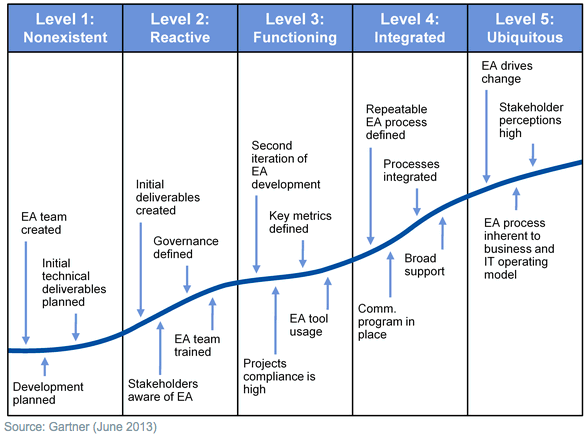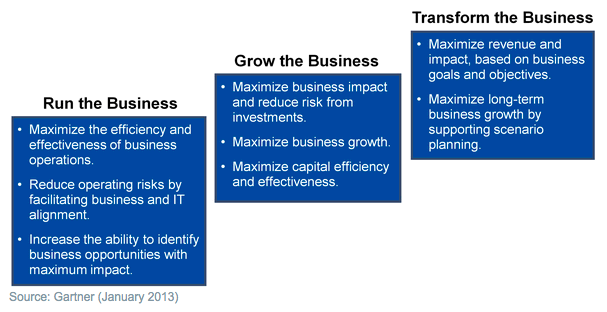EXECUTIVE SUMMARY
This article proposes the establishment of a Center for Operations, Research, and Education (CORE) at your university. CORE would be a team of people that proactively and holistically help achieve the university’s business outcomes. Its mission would be to provide comprehensive educational programs in Enterprise Architecture, conduct research and use this research to help transform the university.
For this article, the strategic direction and cultural factors in relation to operations, research and education in Enterprise Architecture are considered. We assume the status quo in regards to your university’s culture for this assessment, specifically the perception of Information Technology. The following table shows what we considered:
| Operations | Research | Education | |
| Current State (Observations) |
|
|
|
| Future State (Recommendations) |
|
|
|
This assessment reveals that currently where Enterprise Architecture is placed in the organization, it will not be able to provide the organizational transformational value that aspires to provide. Additionally, your university should start providing comprehensive programs in this field otherwise they would be left behind other educational institutions that are already moving in this direction.
1. ANALYSIS
This section provides an analysis of standing up CORE from an operational, research and educational perspective.
Assumptions
- Your university’s executive management would support this effort
- All university communities would help transform it to achieve operational excellence
- Perception of IT would not change instantly
1.1 What is the Center of Excellence?
According to Tarek M. Khalil et al. (2001), within an organization, a Center of Excellence may refer to a group of people, a department or a shared facility. It may also be known as a Competency Center or a Capability Center. The term may also refer to a network of institutions collaborating with each other to pursue excellence in a particular area.
1.2 What is Enterprise Architecture?
Due to the evolving nature of this field, there are many academic and practitioner definitions of what is Enterprise Architecture. For our purposes, we will use the one definition from the glossary on Gartner’s website that states Enterprise Architecture as a discipline for proactively and holistically leading enterprise responses to disruptive forces by identifying and analyzing the execution of change toward desired business vision and outcomes. Enterprise Architecture delivers value by presenting business and Information Technology (IT) leaders with signature-ready recommendations for adjusting policies and projects to achieve target business outcomes that capitalize on relevant business disruptions. Enterprise Architecture is used to steer decision-making toward the evolution of future state architecture.
In a nutshell, “Enterprise Architecture bridges the Business and Information Technology via enterprise integration/standardization resulting in people becoming more efficient and effective in achieving their objectives.” Kevin Smith (2010)
It should be noted that Enterprise Architecture is not an Information Technology endeavor but in fact, it sits in between Business and IT and works across organizational silos.
1.3 What is CORE?
If we combine the two definitions above then a definition for the center of excellence in enterprise architecture emerges which is a team of people that proactively and holistically help achieve business outcomes. For your university and breadth of this center’s agenda, it would be called Center for Operations, Research, and Education (CORE).
1.4 What are the Operational Perspectives?
1.4.1 Why should Your University Pay Attention to Enterprise Architecture?
One of the biggest proponents and users of Enterprise Architecture is the most powerful office in the world – The White House. The United States Federal Government has been using Enterprise Architecture for more than a decade and continues to see it as a way to look across organizational silos.
What this means for your university is that huge organizations are trying to improve their operations and they are turning towards Enterprise Architecture to help them do that. Your university can tap into this, apply Enterprise Architecture effectively and perhaps get involved in Enterprise Architecture discussions for organizational improvements. This involvement could also translate into future research grants and job opportunities for students.
1.4.2 Why putting Enterprise Architecture under Information Technology is Not a Good Idea?
All organizations are a composition of many cultures and subcultures. Some of these cultures develop over time and then become part of the routine mentality of an organization. Your university is not immune to this. In order to understand the perception of Information Technology at your university, look at how the university’s strategic plans were developed. Was Information Technology involved/invited to help in the development of your university’s strategic plan?
If not, then this is a cultural issue and often the cause of misalignments within organizations. Whenever Information Technology is not involved in strategic planning, it gives the perception that Information Technology is not important, it is just a commodity and it is just back-office activities. This lack of involvement is the reason that according to the 2013 Chief Information Officer ‘State of the CIO’ survey, “63% [of the respondents] say the majority of their time and focus is spent on aligning Information Technology initiatives with business goals.” This shows there are gaps in aligning Business and Information Technology. This alignment can be achieved through Enterprise Architecture. According to a Gartner study (G00146809), Business-Information Technology alignment is the primary driver for Enterprise Architecture as shown below:

Taking into consideration the current culture at your university, placing Enterprise Architecture under Information Technology would not make sense. If Enterprise Architecture continues to be placed under Information Technology then at your university Enterprise Architecture would be perceived as an “Information Technology thing”. This perception would defeat the overarching purpose of Enterprise Architecture. Enterprise Architecture needs to have a holistic understanding of your university going beyond Information Technology. A Gartner study (G00245986) supports this thought of Enterprise Architecture going beyond Information Technology as shown below:

From the above figure, we can learn that while technology is a consideration in Enterprise Architecture but it is certainly not the only aspect that needs to be considered. A well-run CORE at your university would consistently produce qualitative and quantitative for both Business and IT. Some of the examples of these are:
- Qualitative Benefits
- Improved Communications Across Organizational Silos
- Increased Productivity
- Efficient Portfolio Management
- Effective Business Intelligence
- Quantitative Benefits
- Reduced Costs
- Revenue Generation
1.4.3 What are the Maturity Levels for Enterprise Architecture?
According to a Gartner study (G00252206), it outlines the five levels of Enterprise Architecture maturity shown below:

What this means is that a lot of work needs to be done in this area and your entire university has to be involved in it so that it can be used effectively across organizational boundaries.
1.4.4 How will CORE Measure its Success?
From an operational perspective, a Gartner study (G00247593) indicates the following ways to align Enterprise Architecture to strategic business initiatives:

At your university, the success of Enterprise Architecture would depend upon how it can help your university transform itself to achieve its strategic visions.
1.5 What are the Educational and Research Perspectives?
1.5.1 Is Enterprise Architecture Taught at Your University?
Are Enterprise Architecture courses taught at your university in various schools (e.g., business school, engineering school, professional studies school, etc.)? If yes, do you know if these schools at your university are talking to each other about Enterprise Architecture? If not, then there is no comprehensive Enterprise Architecture program at your university. From this observation, we can decipher that although Enterprise Architecture might be part of certain programs but overall it is fragmented at your university.
1.5.2 Why Should Your University Teach or Do Research in Enterprise Architecture?
In order to be an elite institution, your university needs to look at what other elite institutions are doing, assess what programs they offer and what kinds of research they are pursuing. Your university should then look at how these programs can be stood up.
For the purpose of this article, we will only focus on the institutions that teach, conduct research and/or have comprehensive programs in Enterprise Architecture. These include:
| Institutions Name | Country | |
| 1 | Harvard University | USA |
| 2 | Massachusetts Institute of Technology | USA |
| 3 | Dartmouth College | USA |
| 4 | Carnegie Mellon | USA |
| 5 | Pennsylvania State University | USA |
2. Recommendations
Due to the importance of Enterprise Architecture as a catalyst in organizational transformation, in the current culture at your university, CORE should not be under IT. CORE’s mission is to help your university continuously evolve, conduct/use research and provide comprehensive educational programs. It should be an interdisciplinary entity whose members include all schools, divisions, and departments of your university. Thus, it should be placed where it has the most influence as shown below:

CORE should start as a chartered center initially led by the School of Business and in collaboration with Engineering School, Professional Studies School and IT. Within the first year, this would develop relationships across all the universities.
CORE’s leadership should be on a rotating basis where each school, department, and division of your university has the opportunity to lead CORE for at least 1 year. This will create an atmosphere of collaboration and help break down organizational silos. This governance structure would also encourage participants to be actively involved in CORE’s advancement and they can use it to also enhance their own schools, divisions, and departments.
In regards to education and research, CORE should develop a graduate certificate program with the goal of creating a Bachelor’s, Masters and executive programs in the future.
References:
- Tarek M. Khalil; L.A. Lefebvre; Robert McSpadden Mason (2001). Management of Technology: The Key to Prosperity in the Third millennium: Selected Papers from Ninth International Conference on Management of Technology, Emerald Group Publishing, pp.164
- IT Glossary, Enterprise Architecture, http://www.gartner.com/it-glossary/enterprise-architecture-ea/
- Kevin Smith (2010), Pragmatic EA: The 160 Character Challenge, Version 1.3, pp.12
- White House (2012), http://www.whitehouse.gov/sites/default/files/omb/assets/egov_docs/common_approach_to_federal_ea.pdf
- CIO Magazine (2013), ‘State of the CIO’ Survey, pp.4
- Robert A. Handler (2007). Key Issues for Enterprise Architecture. Retrieved from Gartner database.
- Julie Short (2013). Agenda Overview for Enterprise Architecture. Retrieved from Gartner database.
- Chris Wilson (2013). ITScore Overview for Enterprise Architecture. Retrieved from Gartner database.
- Betsy Burton (2013). EA Business Value Metrics You Must Have Today . Retrieved from Gartner database.
- Harvard University, IT for Management, http://hbsp.harvard.edu/list/it-for-management-toc
- Massachusetts Institute of Technology, Center for Information Systems Research, http://cisr.mit.edu/research/research-overview/classic-topics/enterprise-architecture/
- Dartmouth College, Auburn Cyber Research Center, http://www.ists.dartmouth.edu/events/abstract-hamilton.html
- Carnegie Mellon, Institute for Software Research, http://execed.isri.cmu.edu/elearning/enterprise-architecture/index.html
- Pennsylvania State University, Center for Enterprise Architecture, http://ea.ist.psu.edu


You must be logged in to post a comment.